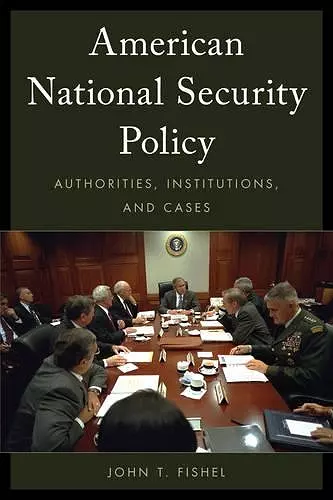American National Security Policy
Authorities, Institutions, and Cases
Format:Hardback
Publisher:Bloomsbury Publishing PLC
Published:15th Feb '17
Currently unavailable, and unfortunately no date known when it will be back
This hardback is available in another edition too:
- Paperback£38.00(9781442248380)

This book explores the intricacies of U.S. national security policy, examining the influences of institutions, legislation, and historical context, while analyzing key case studies from the post-Cold War era to today.
American National Security Policy delves into the intricate process of formulating security policies in the United States, emphasizing their significance in both domestic and international contexts. The book outlines how national security policy is influenced by various factors, including institutions, legislation, and the perspectives of policymakers. It begins by examining the worldview of national security decision-makers, who typically adopt a realist approach, viewing the state as a rational actor focused on pursuing its national interests.
The text further explores the legislative framework that both empowers and restricts these policymakers. It highlights key legal documents, such as the Constitution and the National Security Act of 1947, and discusses the roles of various governmental agencies like the CIA and NSA in shaping policy outcomes. By understanding these legal and institutional contexts, readers gain insight into how security policies are developed and implemented.
Additionally, the book analyzes the practical aspects of national security policymaking, including the creation of reports and how these documents vary across different administrations. Through a series of case studies covering events from the post-Cold War era to the present—such as the Panama crisis, conflicts in Somalia and the Balkans, and the wars in Iraq and Afghanistan—the text illustrates the complexities and challenges of policy implementation. By integrating theory with real-world examples, American National Security Policy offers a comprehensive overview of the factors that influence security policy decisions in the United States.
American National Security Policy should be read by anyone wanting to be a United States national security professional, by anyone who wants to understand how United States national security policy is formulated, and especially by public policy faculty charged with teaching future national security practitioners. These faculty should use this book in their classes. Superbly organized and clearly written, American National Security Policy is a practitioners’ guide to the subject. It explains succinctly how ideas shape policy makers’ world views and then proceeds to describe clearly each of the elements of the United States national security policy-making process. It also contains a varied and fascinating set of cases, in some of which the author was a direct participant, to illustrate points in a manner useful for future practitioners. Readers seeking fiction or fantasy about United States national security policy should avoid this book. Those compelled by facts should give it their full attention. -- Louis W. Goodman, Emeritus Dean of the School of International Service at American University
John Fishel provides a compelling insider's perspective on some of the most important political crises the United States has faced over the past thirty years, including conflicts in Iraq, Afghanistan, Somalia, Yugoslavia, and Panama. As he adeptly demonstrates, the details matter, and lives are lost or saved depending on a complex interaction of policies, ideological agendas, professional relationships, and decisions made by individuals at all levels of the chain of command. Fishel's work has shaped my thinking about national security strategies for a long time, and it will continue to do so for many years to come. -- Adam Lankford, Criminology Professor, The University of Alabama
This is a realistic book about U.S. security policy and a superb starting point for a course on security policy for leaders or students in any country that deals with America—and that’s most of the world. Fishel’s case studies are redolent with the lessons of the generations who have passed through his classrooms. Security policy making is a living art, and the practice has changed with each of the operations described. This is a readable, teachable, text. We can only hope that somewhere in Moscow and Beijing there are Russian and Chinese counterparts working to explain the reality of those powers’ national security policy making. I think that would help to make the world a safer place. -- David Last, Royal Military College of Canada
ISBN: 9781442248373
Dimensions: 235mm x 160mm x 23mm
Weight: 540g
284 pages